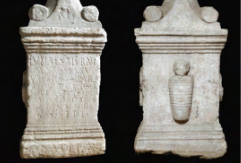Ressenya
Hispano-Roman physician of the 1st century AD, born in Merida or surroundings. In the National Museum of Roman Art (Merida), a marble funerary stele is preserved, dedicated to Julia Saturnina by her husband, highlighting her personal and professional qualities (medica optima). On the back, there is a relief of a newborn wrapped in tight bandages, which means that her professional work would include, among others, the field of obstetrics.
Justificacions
- Hispano-Roman physician in the 1st century AD.
- Her husband refered to her as an "excellent physician" in the epitaph he got written for her.
- It is believed that she was an obstetrician, gynecologist, midwife, pediatrician and childcare specialist.
Biografia
Hispano-Roman physician, born in the first century in Emerita Augusta (Merida). We know about her from an inscription on a burial altar barely one meter high by half a meter wide, which served as a funerary stele, but also as an altar to leave offerings to the deceased. The marble piece shows on the back, in relief, the figure of a newborn wrapped in tight bandages (a common practice of Roman midwives to avoid malformations). It is believed that Julia Saturnina, like other Roman physicians, acted as an obstetrician, gynecologist, midwife, pediatrician, and childcare specialist.
It is said that she belonged to the popular classes, that she was of free status (perhaps she was a citizen) and that she married Cassius Philippus, a man whose freedman origin is not clear (descendant of freed slaves) who may have been a slave.
It seems that she had no descendants because her funerary inscription does not indicate so, but it says that she died at the age of forty-five. Her husband had her epitaph written, highlighting her human and professional virtues: "Incomparable wife, excellent physician, most holy woman".
The stele of Julia Saturnina was found in Merida in 1608; it is currently part of the National Museum of Roman Art (MNAR) in Merida.
Bibliografia
-Alvar, Antonio (dir.), (2019). “Inscripciones latinas en Augusta Emerita”, Base de datos CIL II Digital Mérida. UAH, (retrieved on 02/10/2021), <http://www3.uah.es/cil2digital/inscripciones/ficha/1467/396-inscripciones-sepulcrales?busquedaSimple=1&limistart=0>
-JR. ”Julia Saturnina (s. I)”. La Web de las biografías, (retrieved on 02/10/2021), <http://www.mcnbiografias.com/app-bio/do/show?key=julia-saturnina>
- Mélida y Alinari, José Ramón (1911). “Inscripciones romanas de Mérida y Reina”, in Boletín de la Real Academia de la Historia, 58”. Alicante: Biblioteca Virtual Miguel de Cervantes, (retrieved on 02-10-2021),<http://www.cervantesvirtual.com/obra/inscripciones-romanas-de-mrida-y-reina-0/>
-Mirón Pérez, María Dolores (2000). “Julia Saturnina”, in Mujeres en la Historia de España. Madrid: Planeta, pp. 53-54.
-Sabio González, Rafael ( 2014). “Julia Saturnina: madre o matrona emeritense”, en MNAR d i g i t a l nº 2, p. 9, (retrieved on 02-10-2021), <https://www.culturaydeporte.gob.es/dam/jcr:38f6f3a0-8a6b-4b89-87fb-830403048a44/mnardigital2.pdf>
Enfocament Didàctic
-CUC: Block Classical roots of today's world. History and socio-political evolution; Block Classical roots of today's world. Everyday life.
-Latin 4 ESO: Block The present of Latin civilisation.
-Latin Baccalaureate: Block Ancient Rome.
-History 1 ESO: Block Societies and territories, referring to Rome.
Documents
